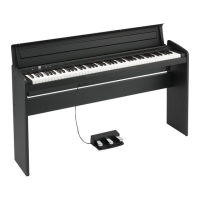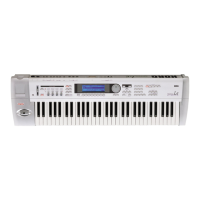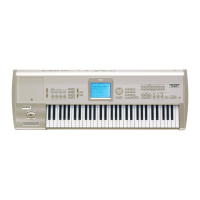PROG P3–1: Filter1 3–1–1: Filter1
47
PROG P3–1: Filter1
Filtering can make subtle or dramatic changes to the
oscillator’s timbre. Each oscillator has two multimode
resonant filters, A and B, as well as a dedicated filter
envelope and keyboard tracking generator.
These pages let you control all aspects of the filters. Among
other things, you can:
• Make basic settings for each oscillator’s filters, including
routing, modes, cutoff, resonance, etc.
• Set up filter modulation, including keyboard tracking,
the filter envelope, LFO modulation, and AMS control.
Note that when the Oscillator Mode is set to Single, only
Oscillator 1’s filters are active; the pages for Oscillator 2’s
filters will be grayed out.
3–1–1: Filter1
This page contains all of the basic settings for Oscillator 1’s
Filter A and Filter B. For example, you can:
• Set up the filters to produce a single 12 dB/oct filter,
dual 12 dB/oct filters in either serial or parallel routing,
or a single 24 dB/oct filter.
• Set each of the two filters to Low Pass, High Pass, Band
Pass, or Band Reject modes.
• Set the cutoff, resonance, and input and output levels of
each filter, including modulation of resonance and
output level.
3–1–1a: Filter Routing
Filter Routing
[Single, Serial, Parallel, 24dB(4Pole)]
Each oscillator has two filters, Filter A and Filter B. This
parameter controls whether one or both of the filters are
used, and if both are used, it controls how they are
connected to each other.
Single. This uses only Filter A as a single 2-pole, 12 dB/
octave filter (6 dB for Band Pass and Band Reject). When this
option is selected, the controls for Filter B will be grayed out.
Serial. This uses both Filter A and Filter B. The oscillator
first goes through Filter A, and then the output of Filter A is
processed through Filter B.
Parallel. This also uses both Filter A and Filter B. The
oscillator feeds both filters directly, and the outputs of the
two filters are then summed together.
24dB/oct. This merges both filters to create a single 4-pole,
24 dB/octave filter (12 dB for Band Pass and Band Reject). In
comparison to Single, this option produces a sharper roll-off
beyond the cutoff frequency, as well as a slightly more
delicate resonance. Many classic analog synths used this
general type of filter.
When 24 dB/oct is selected, only the controls for Filter A are
active; the controls for Filter B will be grayed out.
Serial and Parallel Routing
12db/oct / 24db/oct
3–1–1b:Filter A
Filter Type
[Low Pass (12dB/oct), High Pass (12dB/oct),
Band Pass (6dB/oct), Band Reject (6dB/oct)]
The filter will produce very different results depending on
the selected filter type. The selections will change slightly
according to the selected Filter Routing, to show the correct
cutoff slope in dB per octave.
Low Pass (12dB/oct). This cuts out the parts of the sound
which are higher than the cutoff frequency. Low Pass is the
most common type of filter, and is used to make bright
timbres sound darker.
High Pass (12dB/oct). This cuts out the parts of the sound
which are lower than the cutoff frequency. You can use this
to make timbres sound thinner or more buzzy.
Band Pass (6dB/oct). This cuts out all parts of the sound,
both highs and lows, except for the region around the cutoff
3–1
–1a
3–1
–1
Menu
3–1
–1c
3–1
–1b
Filter A (Low Pass)Oscillator
Serial
Parallel
Filter B (High Pass)
Oscillator
Filter A (Low Pass)
Filter B (High Pass)
Low Pass:
12dB/oct
Low Pass:
24dB/oct

